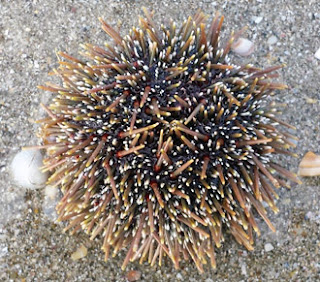At the nearby Goat Island Marine Discovery Centre run by the University of Auckland I told our marine biologist guide about my two daughters' attempts to save some of the homeless hermit crabs from the gulls by offering suitable shells as new abodes. The biologist responded with a story of a visitor who had thrown live starfish back into the water after a mass stranding. Someone else commented that his actions wouldn't make a difference; our guide said that as he continued throwing them, the man replied "It made a difference to that one...and that one...and that one..."
Of course we cannot hope to make much of a difference with such good intentions: nature, after all, is essentially immune to human morality and empathy, with survival at a genetic level the only true sign of success. But do small-scale events whose aftermath I recently experienced - in this case a few days of stormy weather and the resultant strandings - have any long-term effects on the local ecosystem?
Apart from a mass marooning of the large barrel jellyfish Rhizostoma pulmo on a North Wales beach around thirty years ago, I haven't experienced anything similar before. But then until three years ago I didn't live near the sea, so perhaps that's not unlikely! There are fairly frequent news stories from around the world about mass whale or dolphin beachings put down to various causes, some man-made such as military sonar. But as these events involve animals larger than humans they make it onto the news: for smaller creatures such as the crabs and urchins mentioned above, there are unlikely to be any widely-disseminated stories.
It may seem improbable that the balance between organisms could be profoundly altered by local events, but it should be remembered that a few, minor, outside influences over the course of less than a century can wipe out entire species. For example, although the story of how a single cat was responsible for the demise of the Stephens Island wren around the start of the Twentieth Century is an oversimplification of the events, there is evidence that current human activity is inadvertently causing regional change.
One well-known recent illustration is from the Sea of Cortez, where too much game fishing, especially of sharks, may have led to the proliferation a new top predator, the rapidly spreading Humboldt squid. Estimates suggest that the current population in the region is over 20 million individuals (which suits the local squid-fishing industry just fine), but extraordinary considering none were known in the region before about 1950. Two-metre squid may not sound menacing compared to sharks, but the Humboldt squid is a highly-intelligent pack hunter with a razor-sharp beak and toothed suckers on its tentacles, so diving amongst them is probably not for the faint-hearted.
The TV series Cosmos: A Spacetime Odyssey contained a good introduction to the five mass extinctions of the past 450 million years, but it isn't just these great dyings or even El Niño that can upset ecosystems; we may find out too late that relatively minor, local changes are able to trigger a chain reaction at a far wider level. The evolutionary biologist Stephen Jay Gould repeatedly emphasised the importance of historical contingency and the impact of unpredictable, ad-hoc events on natural history. The modern synthesis of evolutionary biology includes the notion that speciation can result from isolation of a population within an 'island'. This latter differs from the strictly geographical definition: a lake, or even an area within a lake, can be an island for some species. If, for example, local changes cause a gap in the ecosystem, then this gap might be filled by an isolated population with the 'fittest' characteristics, in the sense of a jigsaw piece that fits the relevant-shaped hole.
Back to the beach. American marine biologist Rachel Carson's 1951 award-winning classic The Sea Around Us contains an early discussion of the recycling of nutrients within the oceans, but we are now aware that the sea isn't remotely self-contained. My favourite example of an intricate web of land, sea and even aerial fauna and flora centres on the Palmyra Atoll in the Pacific Northern Line Islands. Various seabirds nest in the atoll's high trees, their nutrient-rich guano washing into the sea where it feeds plankton at the base of the offshore food chain. The plankton population feeds larger marine fauna, with certain fish and squid species in turn providing meals for the seabirds, thus completing the cycle. Such a tightly-knit sequence is likely to undergo major restructuring of population densities if just one of the players suffers a setback.
I appear to have followed Stephen Jay Gould's method of moving from the particular to the general and may be a little out of my depth (okay, call it a feeble attempt at a pun) but it certainly gives food for thought when local shallow marine populations appear to suffer after only a few days of mildly inclement weather. If there’s a moral to any of this, it’s that if natural events can affect an ecosystem in unpredictable ways, what havoc could we be causing, with our pesticide run-off, draining of water tables, high-energy sonar, over-fishing and general usage of the oceans as a rubbish dump? The details may require sophisticated mathematics, but the argument is plain for all to see.







